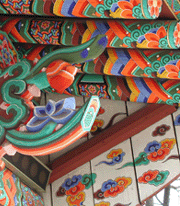|
Bongwon-Temple was originally built on the site of today's Yonsei
University(former Yonhi palace) by Great master Doseon(827-898 A.D.)
in 889 A.D., 3rd year of Jinseong Queen, the 51st of Shilla Dynasty.
And moved this place in 1748, 24th year of Yongjo the Great in Choseon
Dynasty, by high monk Chanjeub and zen master Jeungam, with Buddhists
and the help of the King's authority. The following year, Yongjo
the Great bestowed a signboard inscribing "Bongwon-Temple",
and Buddhist laymen called this temple "Saejeol(New-Temple)",
since this was newly built then. and the present signboard on the
Myongbujeon was autographed by Jeong Dojeon,a great confucianist
in Choseon Dynasty.
Afterward, Jeongjo the Great had established Chilgyu-Jeongso, an
institude for regulating monk's discipline and Promoting Buddhist
society, on this temple. Later, Yi Dongin, the Pioneer monk of last
century, stayed on this for five years. And he taught Kim Okgyun,
the revolutionist for the enlightment of Korea.
Bongwon-Temple has come to grandeur step by step, owing to
continuous reconstruction. And today's appearance was found in 1911
by Yi Bodam, the abbot of this temple. In DEC. of 1945, Kim Giwol
and Kim Unpa and all the resident monks of this temple contributed
to build a large scale of shrine, for the commemoration of Korea's
Independence. But that was unfortunately destroyed during the Korean
war. The signboard "Bongwonsa" written in chinese characters by
Yongjo the Great, and remains of Yi Dongin and Kim Okgyun had burnt
to ashes on that time. In 1966, the abbot of this temple named Choi
Yungwol established the present Main Shrine on the former site.
As the head temple of Korean Buddhist Tae-Go Jong which is the authority
sect of Korean Buddhism family, has many cultural traditions. So
there reside Yi ManBong, Korean Human culture Assets NO. 48 in painting
sect; and Park SongAm, No. 50 in Buddhism Song sect. Now Bongwon-Temple
is doing great efforts for missoinary works and has many Buddhist
Groups; containing Kwaneum Layman Association, Buddhist Young man
Association, Buddhist student Association and Yongsan ritual ceremony
(No 50 intangible cultural assets preservation party).
|


